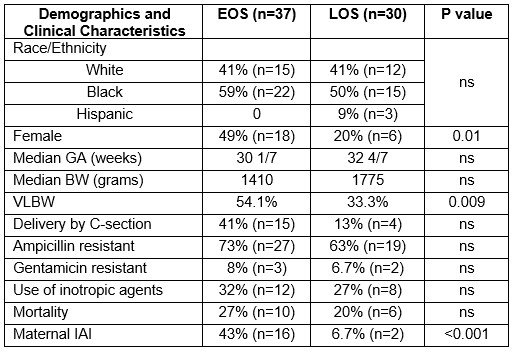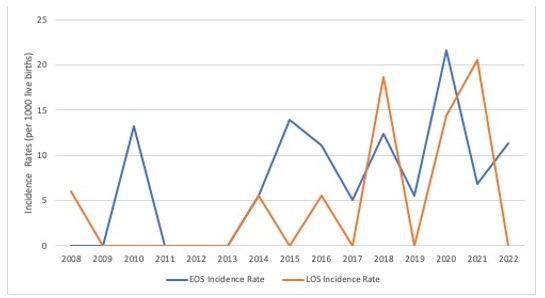Neonatal Infectious Diseases/Immunology
Neonatal Infectious Diseases/Immunology 6
462 - Early and late onset neonatal sepsis: increasing predominance of Escherichia coli in a Level 4 NICU
Publication Number: 462.432

Adriana C. Hoffman, MD (she/her/hers)
Pediatric Resident
UH Rainbow Babies & Children's Hospital
Cleveland, Ohio, United States
Presenting Author(s)
Background:
Neonatal early-onset sepsis (EOS, < 72 hours (h) of life) is usually due to maternal transmission and late-onset sepsis (LOS, >72 h) is often due to nosocomial or community-acquired infections. Escherichia coli (E. coli) is the most common cause of EOS in infants whose birth weight is < 1500 grams (VLBW, very low birth weight) and has been reported to be increasing in incidence in EOS and LOS for all infants. There is increasing E. coli resistance to ampicillin (amp), part of the current empiric regimen of EOS. In our center, ceftazidime was added in 2019 to the EOS empiric regimen of amp and gentamicin for VLBW infants with risk factors such as prolonged rupture of membranes.
Objective: To identify the incidence of E. coli neonatal sepsis over time, differentiating features between E. coli EOS and LOS, and whether changing our empiric antibiotic regimen decreased neonatal mortality.
Design/Methods: Data were collected after IRB approval on all neonates admitted to Rainbow Babies and Children’s Hospital in Cleveland, OH from 2008 through 2022 with positive blood or cerebrospinal fluid culture for E. Coli. Analyses were performed using Prism.
Results:
There were 67 E. coli cases identified. Infants with E. coli LOS (45%) were more likely to be male and birth weight >1500g compared to infants with E. coli EOS (Table 1). In the 2,451 VLBW infants admitted during the study period, there were 20 E. coli EOS cases (8.2/1000 births) and 10 E. Coli LOS cases (4.1/1000 births). E. coli sepsis in VLBW infants increased significantly since 2019 [9.4 (2008-18) to 20.9 (2019-22) per 1000 births, p=0.001], equally attributable to EOS and LOS. Mortality from E. coli EOS and LOS was 27% and 20% respectively in all infants and increased to 50% and 30% respectively in VLBW infants. Since our empiric antibiotic changes in 2019, VLBW E. coli mortality trended upwards [from 35% (2008-18) to 46% (2019-22)] although not significant. Amp resistance was 69% overall and did not vary over time. There were no significant differences in mortality, VLBW status and EOS vs LOS between amp resistant and sensitive strains.
Conclusion(s): E. coli EOS/LOS and related mortality in VLBW infants has increased in the last four years at our center. Most of E. coli LOS occurs in males. Most E. coli isolates are amp resistant, but this appears to be independent of pathogenicity and mortality. Addition of empiric cephalosporins in VLBW infants did not significantly affect mortality at our center. Examining trends of E. coli sepsis rates, mortality and their relation to resistance profiles are critical in guiding antibiotic choices.


